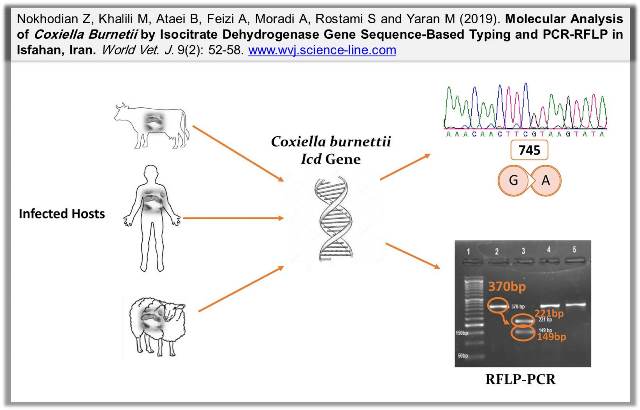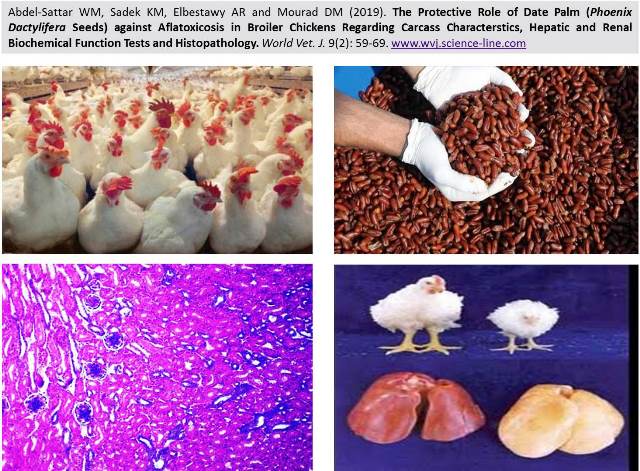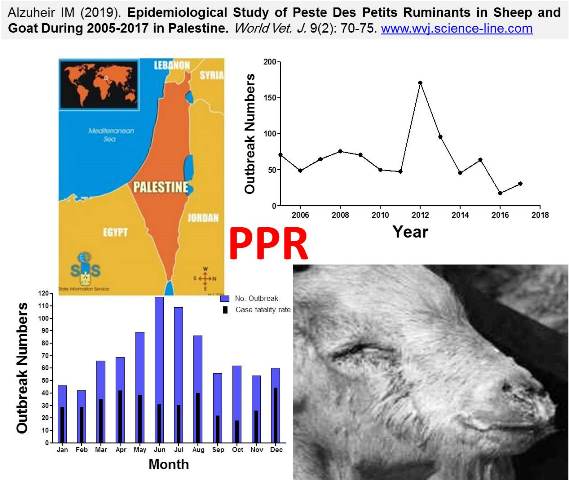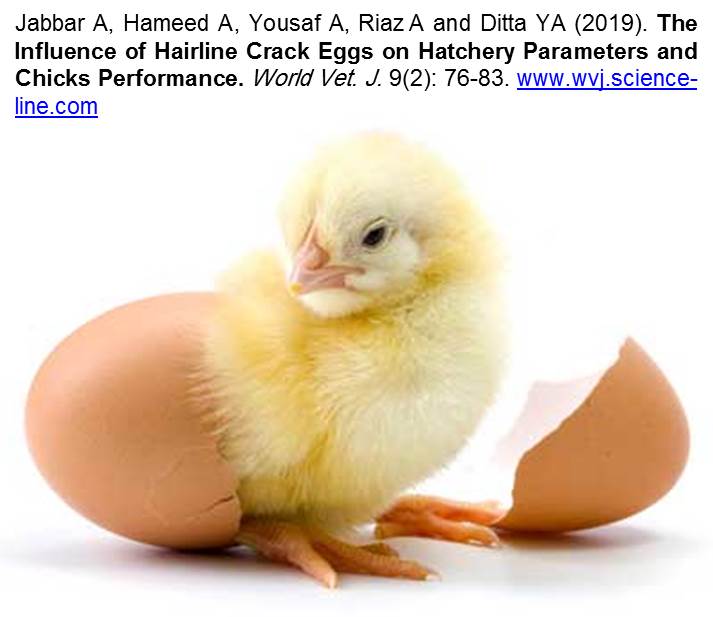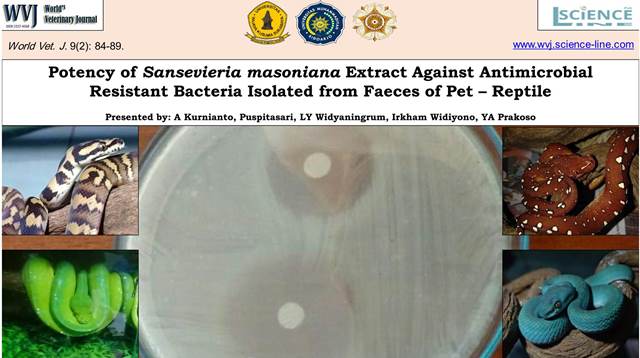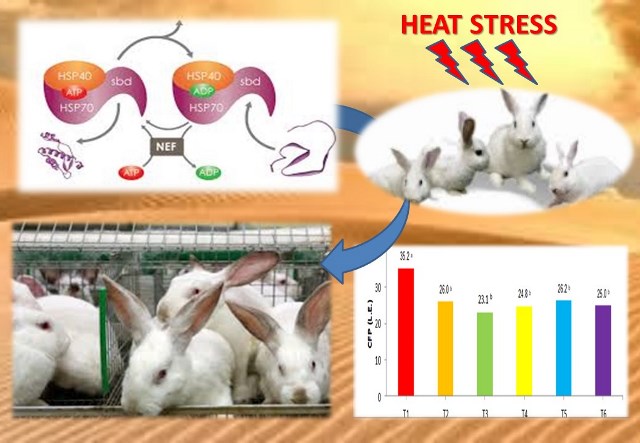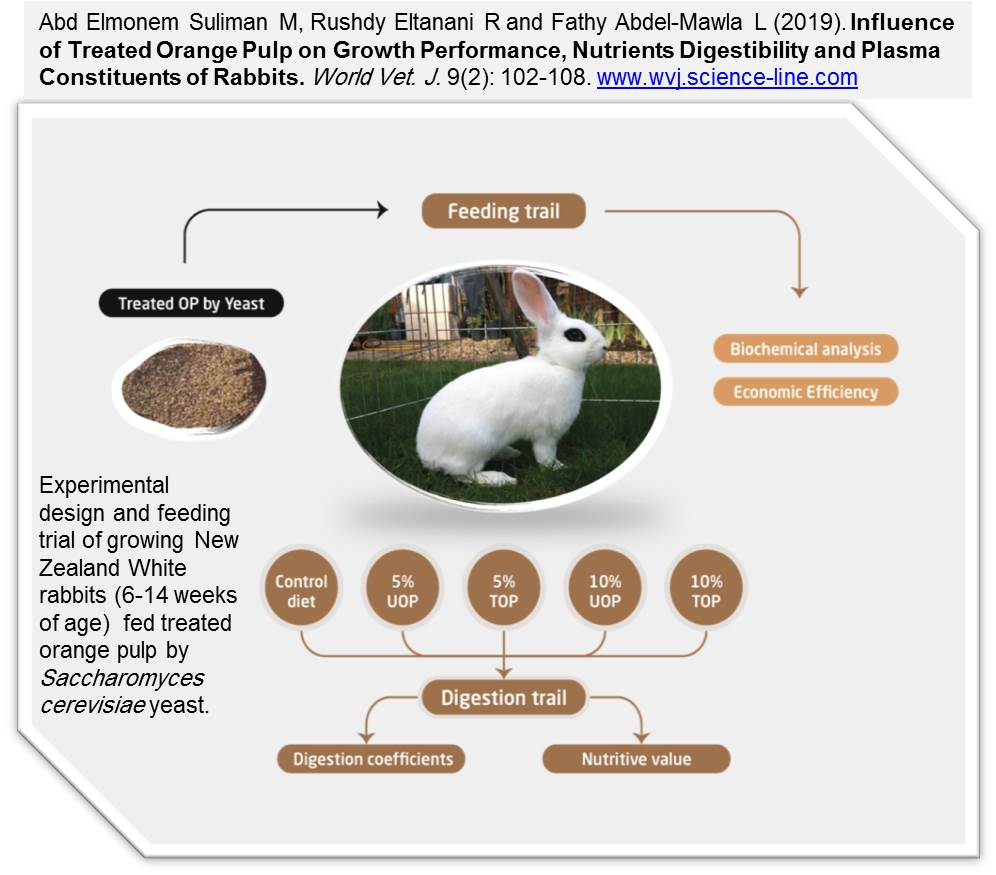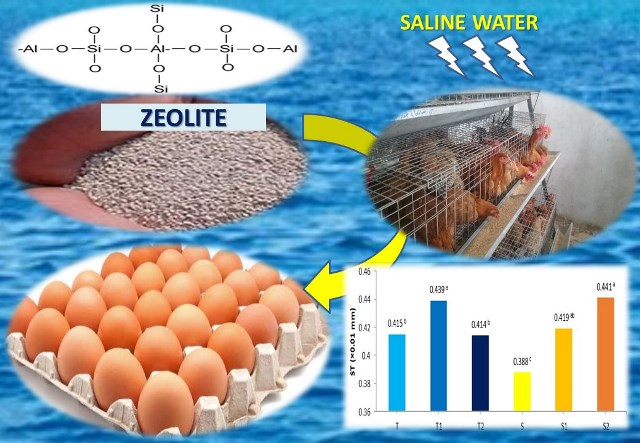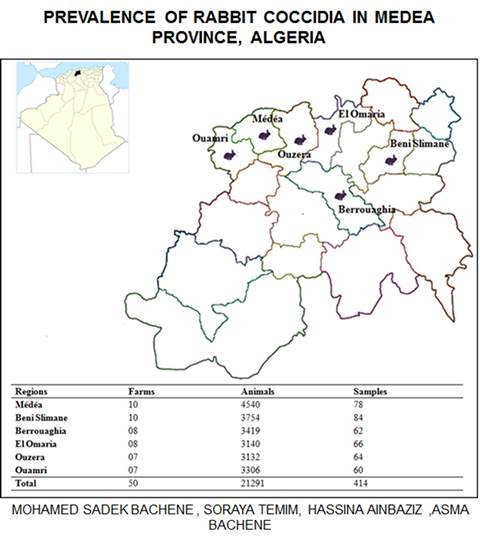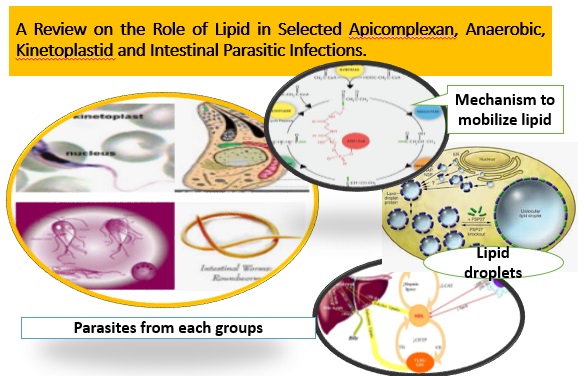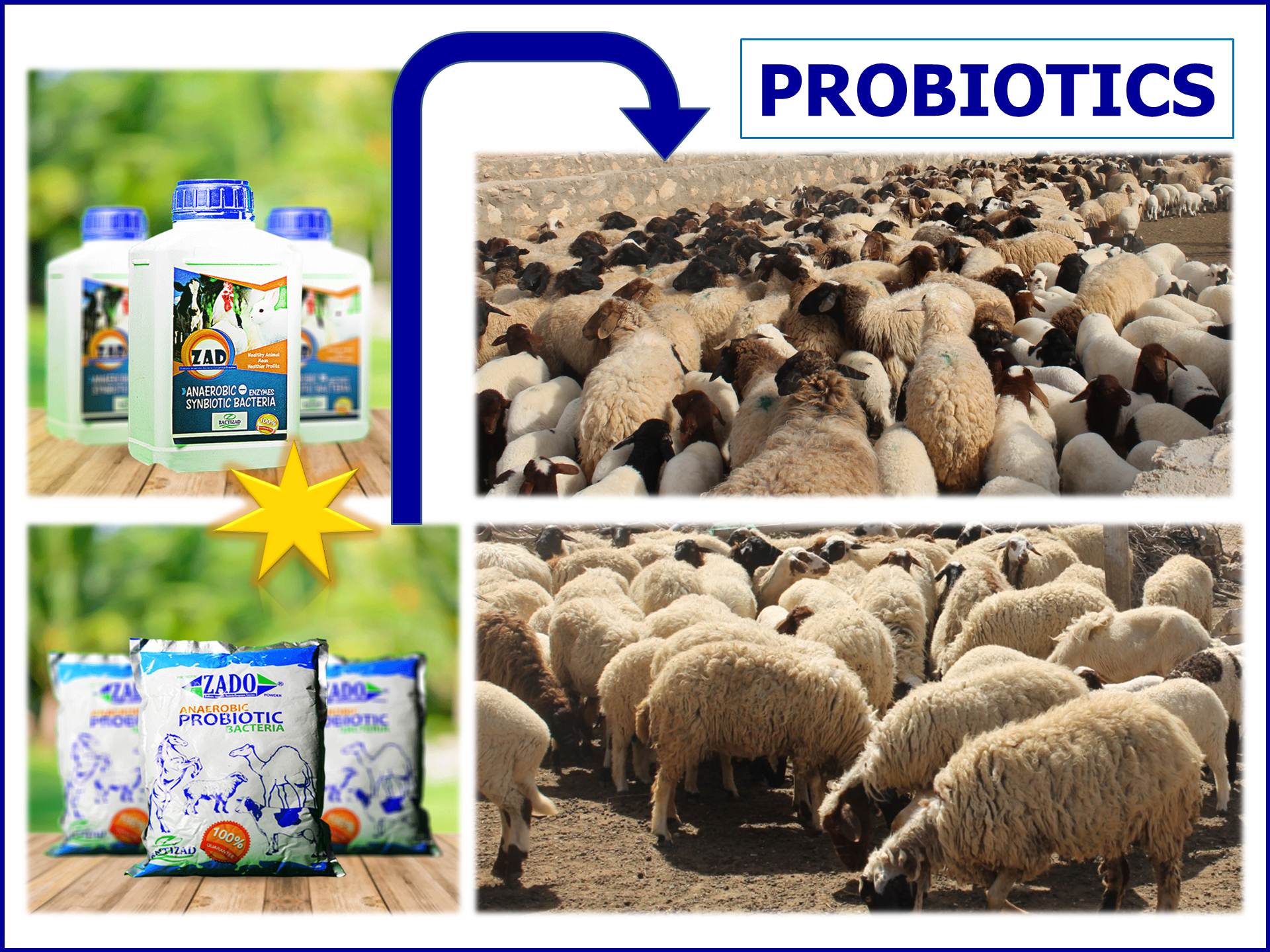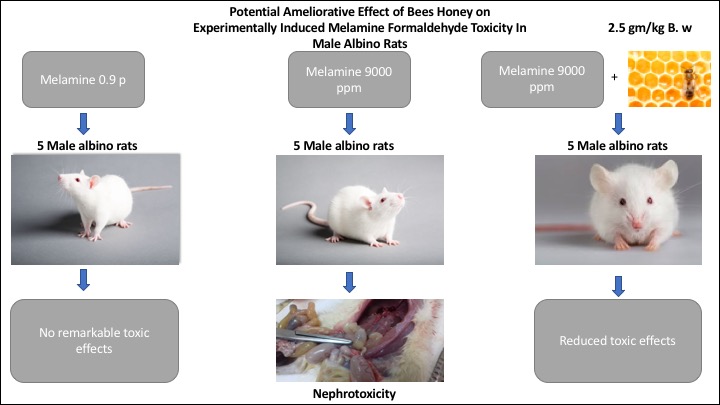Previous issue | Next issue | Archive
![]() Volume 9 (2); June 25, 2019 [Booklet] [EndNote XML for Agris]
Volume 9 (2); June 25, 2019 [Booklet] [EndNote XML for Agris]
Molecular Analysis of Coxiella Burnetii by Isocitrate Dehydrogenase Gene Sequence-Based Typing and PCR-RFLP in Isfahan, Iran.
Nokhodian Z, Khalili M, Ataei B, Feizi A, Moradi A, Rostami S and Yaran M.
World Vet. J. 9(2): 52-58, 2019; pii:S232245681900008-9
DOI: https://dx.doi.org/10.36380/scil.2019.wvj8
ABSTRACT
In the recent years, considerable advances have been made in the detection and genotyping of Coxiella burnetii, the causative agent of Q fever. The selection of appropriate genotyping method has enabled description of the clonal diversity of C. burnetii around the word. Since, in the place of study, C. burnetii genotyping has not been done, the icd gene Restriction fragment length polymorphism (RFLP) and sequence-based typing for differentiation between the genomic detected C. burnetii from the various sources and compared the two methods is used. In a observational study, a total of 15 genomic positive cases of C. burnetii infection from different sources in Isfahan province (Central Iran) were enrolled and underwent two genotyping methods: the icd gene PCR-RFLP and icd gene sequence-based typing. The degree of similarity between the icd gene sequences was high (98.3-100%). In compare with C. burnetii Nine Mile icd gene sequence, the nucleotide sequences were different at 11 positions, which resulted in 7 differences in the amino acid sequences. After digesting the 370 bp amplified icd gene fragments all the samples indicated only one band of 370bp, while amplified C. burnetii Nine Mile strain icd gene were digested into two bands with sizes of 221bp and 149bp. The results of two genotyping methods matched together. Used methods in present study were cheaper and easier than new methods and they can used for detection of acute and chronic phases of infection.
Keywords: Coxiella burnetii, Isocitrate dehydrogenase, Iran, Restriction fragment length polymorphism, Sequence-based typing
[Full text-PDF] [XML] [Import into EndNote] [Citations on Google Scholar]
The Protective Role of Date Palm (Phoenix Dactylifera Seeds) against Aflatoxicosis in Broiler Chickens Regarding Carcass Characterstics, Hepatic and Renal Biochemical Function Tests and Histopathology.
Abdel-Sattar WM, Sadek KM, Elbestawy AR and Mourad DM.
World Vet. J. 9(2): 59-69, 2019; pii:S232245681900009-9
DOI: https://dx.doi.org/10.36380/scil.2019.wvj9
ABSTRACT
Harmful effects caused by aflatoxin (AF) directed researchers towards to find out new strategies for its control and detoxification increasing the safety of poultry feed. The aim of the present work was to study the protective role of date pits (Phoenix dactylifera) seeds against aflatoxicosis regarding carcass traits, biochemical function tests and histopathology of both liver and kidney in broiler chickens. 210 one-day old Arbor Acres broiler chicks were allotted into 7 equal groups as the first control (G1) supplemented by the basal diet, G2 had the basal diet with date pits supplementation 2%, G3 fed on the basal diet with date pits 4%, G4 was fed a basal diet containing 100µg aflatoxin/kg (100 ppb). G5 fed on a basal diet containing Hydrated Sodium Calcium Aluminum Silicates (HSCAS) 0.3% plus aflatoxin, (G6) fed a basal diet containing date pits 2% plus aflatoxin and finally G7 fed a basal diet containing date pits 4% plus aflatoxin. The aflatoxin supplemented to the broiler ration from first day to the end of experiment at 35 days. Aflatoxins supplementation significantly increased relative liver and small intestine weight, affect liver and kidney biochemical function tests and induced histopathological changes as fatty degeneration of hepatocytes, and interstitial nephritis with mononuclear cell infiltrations in both liver and kidney, respectively. However, addition of date pits (2% and 4%) and HSCAS (0.3%) to broiler's diet partially ameliorated these harmful effects of aflatoxins, indicating their protective effect against aflatoxicosis and this protection is dose-related. Addition of date palm seed (2% and 4%) gave a better results regarding carcass traits, biochemical parameters and histopathological examination of liver and kidney, finally concluding that date palm seed powder could be used as an effective feed additive to control aflatoxicosis in poultry with avoiding harmful effect of chemical mycotoxin binders (HSCAS).
Keywords: Aflatoxins, Broilers, Biochemical traits, Carcass characteristics, Date palm, Histopathological changes.
[Full text-PDF] [XML] [Import into EndNote] [Citations on Google Scholar]
Epidemiological Study of Peste Des Petits Ruminants in Sheep and Goat During 2005-2017 in Palestine.
Alzuheir IM.
World Vet. J. 9(2): 70-75, 2019; pii:S232245681900010-9
DOI: https://dx.doi.org/10.36380/scil.2019.wvj10
ABSTRACT
The objective of this study was to analyze the epidemiological occurrence of Peste des petits ruminants in sheep and goat in Palestine during 2005-2017. Data were collected from the annual agricultural census released by the Palestinian central bureau of statistics and the reports of world organization for animal health, submitted by the general directorate of veterinary services and animal health between 2005 and 2017. The study indicated that Peste des petits ruminants is enzootic in Palestine, reported in each year of the study period. The incidence rate ranged from 1.78 to 14.36% with an average of 6.39% per year and per 104 animals. The average morbidity, morbidity and case fatality rate were 8.89%, 2.89%, and 33.57% respectively. Temporal analysis obtained that Peste des petits ruminants is more epizootic in the dry season between April and August with a significant peak on June. The Peste des petits ruminants vaccination rate in Palestine was low and not well organized, ranged from 0.77-34.39% with an average rate of 9%. The appropriate data recording, improving owner awareness, expand the use of the Peste des petits ruminants vaccine and a systematic disease monitoring program are required to control the spread of the disease.
Keywords: Epidemiology, Goat, Palestine, Peste des petits ruminants, Sheep
[Full text-PDF] [XML] [Import into EndNote] [Citations on Google Scholar]
The Influence of Hairline Crack Eggs on Hatchery Parameters and Chicks Performance.
Jabbar A, Hameed A, Yousaf A, Riaz A and Ditta YA.
World Vet. J. 9(2): 76-83, 2019; pii:S232245681900011-9
DOI: https://dx.doi.org/10.36380/scil.2019.wvj11
ABSTRACT
The The purpose of study was to evaluate the influence of hairline crack eggs on hatchery parameters and later life of chicks. The study was conducted from October to December 2018 at Chakri hatchery Salman Poultry Pvt. Ltd Pakistan to evaluate the outcomes of hairline crack eggs. The shell of the eggs is essential in providing the shape of an egg and ensuring the safe packaging. The defects like breakage of this packaging increase the risk of microbial contamination. In this experiment, the crack eggs like hairline crack eggs were detected by Sanovo STAALKAT Alpha 125 Machine number JB 11786. The eggs were collected from eighteen different breeder farms. Each group contained (n= 50,000) eggs. The hairline crack eggs were compared with normal eggs for hatchability, candling, putrification/blasting and dead in shell. Significant difference was found for hatchability, candling, blasting/putrification and dead in the shell for normal and hairline crack eggs. The highest hatchability (49.07 ± 0.51b) and lowest candling (9.98 ± 0.064a) for hairline crack eggs were found for AP27 due to young age and good quality eggshell. The lowest hatchability was found for SP117 which is the oldest flock having thin egg shells. The blasting/putrification and dead in the shell were significantly higher for hairline crack eggs as compared normal eggs of same flocks. The highest blasting of hairline crack eggs was found for SSF6 f, SSF1. The dead in the shell was found highest for SSF6; SSF1 for the hairline crack eggs while lowest blasting was found for AP27 due to young age with good quality eggshell. On simple hatch debris analysis, the highest 1stweek mortality, infertile, contaminated eggs and 3rd week mortality were found for hairline crack eggs as compared to normal eggs for SSF5 flock. The water loss, chick yield and culling chicks percentage were also significantly better for normal eggs compared to hairline crack eggs. The hairline crack eggs of young flocks were better than old flocks due to a better quality of eggs shell. The chicks from normal eggs were also significantly better than chicks from hairline crack eggs in terms of mortality, feed intake, weight gain and FCR. The hairline crack eggs are the source of contamination. Such kinds of eggs should not be used for incubation.
Keywords: Candling, Dead in shell, Hairline crack, Hatchability, Water loss
[Full text-PDF] [XML] [Import into EndNote] [Citations on Google Scholar]
Potency of Sansevieria masoniana Extract against Antimicrobial Resistant Bacteria Isolated from Faeces of Pet – Reptile.
Kurnianto A, Puspitasari, Widyaningrum LY, Widiyono I and Prakoso YA.
World Vet. J. 9(2): 84-89, 2019; pii:S232245681900012-9
DOI: https://dx.doi.org/10.36380/scil.2019.wvj12
ABSTRACT
Reptile plays an essential role in human life and act as a reservoir of pathogenic bacteria. It became necessary because of some bacteria resistant against several antibiotics. This study aimed to evaluate the potency of Sansevieria masoniana (SM) leaf extract against isolated bacteria from the faeces of pet-reptile. A total of 129 fresh faecal samples were collected from the reptile communities in Surabaya on February 2018 until January 2019. The faeces obtained from 72 snakes, 43 lizards and 14 tortoises. The isolation was conducted using the Micro ID system. All the isolated bacteria were tested against several antibiotics using disc diffusion method, and SM extract using minimum inhibitory concentration test. The isolated bacteria were Aeromonas hydrophila (44.96%), Bacillus sp (32.55%), Enterobacter cloacae (40.31%), Enterococcus sp (82.17%), Escherichia coli (96.89%), Proteus sp (76.74%), Pseudomonas sp (48.83%), Salmonella enteritidis (55.03%), and Salmonella enterica arizonae (53.48%). Those isolated bacteria indicated various resistance patterns against several commercial antibiotics. The minimum concentration of SM extracts that potential to inhibit the colonisation of both resistant and susceptible isolated bacteria was 62.5 mg/mL. This study proved that SM extract potential to inhibit the colonisation of the isolated bacteria from faeces of pet-reptile, even though, several of those isolates resistant against several commercial antibiotics.
Keywords: Antibiotic, Pet – reptile, Reservoir, Resistance, Sansevieria masoniana.
[Full text-PDF] [XML] [Import into EndNote] [Citations on Google Scholar]
Effect of Early Heat Shock Exposure on Physiological Responses and Reproduction of Rabbits under Hot Desert Conditions.
Sakr OG, Mousa BH, Emam KRS, Morsy AS and Ahmed NA.
World Vet. J. 9(2): 90-101, 2019; pii:S232245681900013-9
DOI: https://dx.doi.org/10.36380/scil.2019.wvj13
ABSTRACT
This study aimed to apply early heat shock exposure programs for releasing HSP70 gene expression to improve production of rabbits reared under hot desert conditions at Egypt. 120 Hi-Plus rabbits, one-day old were randomly divided into six equal treatments (20 rabbits/ treatment), namely T1, T2, T3, T4, T5 and T6. T1 served as control. The rabbits of second, third, fourth, fifth and sixth treatments were exposed to heat shock (36±1 °C for 3 hours from 12:00 - 15:00 for three successive days). Rabbits of T2, T3, T4, T5 and T6 were exposed to heat shock at 3, 25, 60, 3+25 and 3+25+60 days of age, respectively. HSP70 expression and tri-iodothyronine hormone in the rabbits of T2, T3, T4, T5 and T6 were significantly increased. Rectal and fur temperatures, respiration rate, alanine transaminase, corticosterone hormone levels and overall mortality rate significantly decreased in the rabbits exposed to heat shock programs. Red blood cells count, packed cell volume and hemoglobin concentration increased in the rabbits of T2, T3 and T4. Total protein and globulin concentrations increased in the rabbits of T5 when compared to the rabbits of T1, T2 and T6. However, rabbits of T2 and T4 showed an increase in total antioxidant capacity when compared to the rabbits of T1. Conception rate was higher in the does of T5 than that in T3, T4 and T6. Litter traits, productive efficiency index, feed conversion and cost of feeding improved in the rabbits exposed to heat shock programs. In conclusion, applying heat shock exposure programs of rabbits especially T3 treatment, might increase HSP70 gene expression, this led to enhance immunity responses and production under severe heat stress conditions.
Keywords: Heat stress, HSP70, Physiological responses, Productive and reproductive performance, Rabbits
[Full text-PDF] [XML] [Import into EndNote] [Citations on Google Scholar]
Influence of Treated Orange Pulp on Growth Performance, Nutrients Digestibility and Plasma Constituents of Rabbits.
Abd Elmonem Suliman M, Rushdy Eltanani R and Fathy Abdel-Mawla L.
World Vet. J. 9(2): 102-108, 2019; pii:S232245681900014-9
DOI: https://dx.doi.org/10.36380/scil.2019.wvj14
ABSTRACT
The current study investigated the effect of replacement of Untreated Orange Pulp (UOP) and Treated Orange Pulp (TOP) protein by basal diet protein on growth performance, digestion coefficients, some blood constitute of rabbits and economic efficiency of growing rabbit diets. Sixty cross bread (New Zealand White, NZW X California), six weeks of age with live body weight ranging from 729.20 to 738.30g were divided to five experimental groups. The experimental diets were T1, control diet without OP; T2, 5%UOP; T3, 5% TOP; T4, 10%UOP and T5, 10%TOP. The results indicated that TOP by Saccharomyces cerevisiae yeast increased content of the crude protein (%) and digestible energy (Kcal/kg). The best Final Body Weight (FBW, g), Body Weight Gain (BWG, g/R/day) and feed conversion ratio recorded in 5%TOP group. Digestion coefficient of Crude Protein and Digestible Crude Protein (DCP%) were significantly (P˂ 0.05) increased in rabbits fed low replacement level of OP (5% UOP and 5%TOP). Total lipid of plasma was significantly differences (P˂ 0.05) in groups fed experimental diets compared to control group. Liver function was significantly affected by experimental diets, yeast treatment and replacement level of OP. Best economic efficiency observed with 10%UOP followed by 5%TOP. It was concluded that rabbit group fed 5%TOP recorded a better performance, best digestibility for CP%, DCP and economic efficiency. Saccharomyces cerevisiae yeast treatment didn't effect on digestibility and nutritive value of growing rabbits.
Key words: Digestibility, Economic, Growing rabbits, Performance, Plasma, Yeast.
[Full text-PDF] [XML] [Import into EndNote] [Citations on Google Scholar]
Effect of Zeolite Dietary Supplementation on Physiological Responses and Production of Laying Hens Drinking Saline Well Water in South Sinai.
Emam KRS, Toraih HM, Hassan AM, El-Far AA, Morsy AS and Ahmed NA.
World Vet. J. 9(2): 109-122, 2019; pii:S232245681900015-9
DOI: https://dx.doi.org/10.36380/scil.2019.wvj15
ABSTRACT
This study conducted to investigate the effects of dietary zeolite on egg production, egg quality and blood constituents of hens under drinking saline well water. 180 hens were randomly divided into six equal groups (30 hens / group). 1st group (T), hens drank tap water and fed basal diet. The 2nd group (T1), hens drank tap water and fed diet containing 2 % zeolite. The 3rd group (T2), hens drank tap water and fed diet containing 4 % zeolite. 4th group (S), hens drank saline well water and fed basal diet. 5th group (S1), hens drank saline well water and fed diet containing 2 % zeolite. 6th group (S2), hens drank saline well water and fed diet containing 4 % zeolite. Red blood cells and hemoglobin were significant lower in the hens of S compared to other treatments. Hens of S group showed significant decrease in total protein, globulin, glucose and total antioxidant capacity concentrations as compared to the hens of T and T2 groups. Alanine transaminase, aspartic transaminase and creatinine were significantly increased in the hens of S group compared to other treatments. Aldosterone hormone was significantly decreased in the hens of S compared to them in T, T1 and T2 groups. Egg weight significantly increased in the hens of S2 compared with hens in T and S groups. Egg number and egg mass were significant increase in the T1, T2 and S2 compared to hens in T, S and S1 groups. Hens of T1, T2 and S2 groups had significantly improved feed conversion compared to hens of S group. Hens of S group had significantly decreased shell thickness compared to other treatments. In conclusion, under drinking saline well water, addition of zeolite to laying hens' diets at levels 4 % might improve productive performance and eggshell quality.
Keywords: Hematological parameters, Laying hens, Productive performance, Saline water, Zeolite.
[Full text-PDF] [XML] [Import into EndNote] [Citations on Google Scholar]
Prevalence of Rabbit Coccidia in Medea Province, Algeria.
Bachene MS, Temim S, Ainbaziz H and Bachene A.
World Vet. J. 9(2): 123-128, 2019; pii:S232245681900016-9
DOI: https://dx.doi.org/10.36380/scil.2019.wvj16
ABSTRACT
Coccidiosis has an economic impact for poultry and livestock. The current study examined the prevalence of Eimeria infections in domestic rabbits in Medea province, North of Algeria. A total of 414 faecal samples were collected from 50 farms in six regions of the province. Each faecal sample was subjected to oocyst counting and isolation. The Eimeria species from samples containing isolated and sporulated oocysts were morphologically identified microscopically. The overall prevalence of coccidial infections was 47.6% (197/414). Weaners had the highest prevalence (77%, 77/100, P< 0.0001), followed by growing rabbits (46.8%, 30/64) and the adult rabbits showed the lowest prevalence (36%, 18/50). In breeding rabbits, females were more infected with a prevalence of 40% (P< 0.0001). Eleven rabbit Eimeria’s species were present and identified from oocyst positive samples. Eimeria magna and Eimeria media were the most prevalent species (47.6% and 47.3%). Sulfonamides showed a better protection against rabbit coccidiosis than colistin and trimethoprim association (P< 0.0001, prevalence of 23.3% vs. 65.3% respectively). These results indicated that the prevalence of coccidiosis is high among the rabbit population in Medea province, North of Algeria. As a conclusion, it seems that the epidemiological situation of rabbit coccidiosis in Medea province must be taken into consideration in order to minimize the economic losses caused by this parasitosis.
Keywords: Eimeria, Oryctolagus cuniculus, Rabbit, Sulfonamides
[Full text-PDF] [XML] [Import into EndNote] [Citations on Google Scholar]
Review
A Review on the Role of Lipid in Selected Apicomplexan, Anaerobic, Kinetoplastid and Intestinal Parasitic Infections.
Yesuf M and Kenubih A.
World Vet. J. 9(2): 129-134, 2019; pii:S232245681900017-9
DOI: https://dx.doi.org/10.36380/scil.2019.wvj17
ABSTRACT
Lipids are a diverse class of biomolecules that play a major role as energy source, membrane components and cellular signaling molecules. Because of the variation in modes of life, different parasites can partly or fully utilized significant amount lipids during infection. The aims of this paper were to provide an overview to the role of lipids in selected apicomplexan, anaerobic, kinetoplastid and intestinal parasitic infections. Lipid particles are fundamentally engaged in host-pathogen interactions like cell signaling and immunity. As a sources of eicosanoid production, they are involved in different aspects of innate signaling and antigen presentation for the host organism. For the pathogen, lipid droplets also employed to facilitate attachment, empowering pathogenesis and used to subvert host metabolism as ways of immune evasion. The apicomplexan parasites utilized lipid particles for various purpose including changing permeability and fragility of host cells, support the insertion of parasite into the host cell membrane, and promote growth, invasion and optimal replication of the organism. In anaerobic groups of parasites, the lipid plays a considerable role as growth promoter, increasing virulence, facilitate encystation and vesicle formation as well as initiation of immune system and maturation of dendritic cells. Kinetoplastid also engaged in the uptake of essential lipid particles to produce more complex lipids, develop protective mechanisms against host innate and adaptive immunity and support pathogen survival. The lipid bodies also utilized by the intestinal parasites for disease pathogenesis, differentiation and survival of larvae in the host tissue. This review showed that the different in vivo and in vitro studies indicated that lipids have different role in different stage of the parasites infection. The associations between parasites and the lipids were observed during the attachment, invasion and other stages of parasitic infection. So far, evidences in lipid profile alteration related to different parasitic infection suggested that parasites are able to remodel/metabolize host lipids during the overall pathogenesis of parasitic infection.
Keywords: Infection, Lipid, Parasitic, Role
[Full text-PDF] [XML] [Import into EndNote] [Citations on Google Scholar]
Productive and Reproductive Performance and Metabolic Profile of Barki Ewes Supplemented with Two Forms of Probiotics as Feed Additives.
El-Hawy AS, El-Bassiony MF, Abo Bakr S, Gawish HA, Badawy MT and Gado HM.
World Vet. J. 9(2): 135-145, 2019; pii:S232245681900018-9
DOI: https://dx.doi.org/10.36380/scil.2019.wvj18
ABSTRACT
Present study aimed to evaluate the impacts of probiotic mixtures as a biological feed additive on the reproductive and productive performance of Barki ewes under desert conditions. A total number of 100 Barki ewes were randomly assigned and divided into five equal groups (20 each) to evaluate the effect of different levels and forms of biological additives mixtures on Barki ewes productivity. The first mixture of probiotic added as liquid forms (Mixture Probiotic Liquid, MPL), while the second added as powder forms (Mixture Probiotic Powder, MPP). The two forms of enzymes used at two levels (6 and 10ml or g/h/d). The two additives formed of exogenous enzymes and obtained through an anaerobic fermentation process of Ruminococcus flavefaciens. The results indicated that feed intake was higher in MPL and MPP treated groups compared to control group. During pregnancy and lactation stages, MPL and MPP groups recorded significantly increase in ewes body weight. The conception and lambing rates were tended to differ between groups, but the number of lambs born alive was significantly higher in MPP groups [19 lambs for group 2 (G2) and 18 lambs for group 3 (G3)] followed by MPL groups (16 and 18 lambs for group 4 (G4) and group 5 (G5), respectively), while the control group recorded 18 lambs. The mortality rate from birth to weaning decreased (P<0.05) in treated groups with 5%, 5%, 0% and 5% for G2, G3, G4 and G5, respectively, while the mortality rate increased (P<0.05) by 11% in control group. The milk yield tended to increase in MPP then MPL groups. The birth and weaning weights as well as average daily gain increased (P<0.05) in MPL and MPP groups. Thyroid hormones T3 and T4 concentrations increased (P<0.05) with enzymes mixtures supplementations. In conclusion, under the semi-arid conditions, supplementation of exogenous enzyme preparations of MPL and MPP to sheep rations, may improve weaning weight and daily gain of lambs as much as live body weight and milk production of ewes.
Keywords: Biological additives, Productive performance, Reproduction, Milk, Barki sheep
[Full text-PDF] [XML] [Import into EndNote] [Citations on Google Scholar]
Potential Ameliorative Effect of Bee Honey on Experimentally Induced Melamine Formaldehyde Toxicity in Male Rats.
Hamouda AF, Amin AAE, Ibrahim SS, and Mahmoud MA.
World Vet. J. 9(2): 146-157, 2019; pii:S232245681900019-9
DOI: https://dx.doi.org/10.36380/scil.2019.wvj19
ABSTRACT
Melamine is considered as one of urea derivatives. Recently it is added to feed stuffs for industrial purposes (falsely elevate its protein contents), however addition of melamine resulted in marked oxidative stress and toxic effect on different body organs, especially the nephrotoxicity and urolithiasis. Therefore, this work is designed to explore the beneficial effect of bee’s honey to alleviate the harmful effect induced by melamine toxicity and to show the histological changes on male albino rats. In this work seven animal groups (five rats for each), group 1; negative control, while groups 2, 4, 6 received melamine-formaldehyde orally at dose 0.9, 90, 9000 ppm, respectively while groups 3, 5, 7 received the same melamine dose beside bee’s honey (dose of 2.5 gm/kg body weight (B. w) for 45 days. Results declared that melamine treated rats showed marked oxidative, biochemical, hematological changes as well as pathological alterations in vital assets especially liver and urinary system. As distension of the urinary bladder, crystals deposition and stone formation were detected with variable degrees in all groups treated only with melamine. Microscopically, various pathological changes in kidneys, liver, lung, heart and intestine were also demonstrated. The severity of these changes varied from mild to severe changes depending upon the dose of melamine. Interestingly, rats treated with melamine plus the bee’s honey showed mild changes in comparison to the only melamine treated rats. These findings assured that, marked antioxidant and ameliorative effect of bee’s honey successfully reduced the noxious effect of melamine on different body organs.
Keywords: Melamine, Vital assets toxicity, Bee’s honey, White albino rats
[Full text-PDF] [XML] [Import into EndNote] [Citations on Google Scholar]
Previous issue | Next issue | Archive
![]() This work is licensed under a Creative Commons Attribution 4.0 International License (CC BY 4.0).
This work is licensed under a Creative Commons Attribution 4.0 International License (CC BY 4.0).



